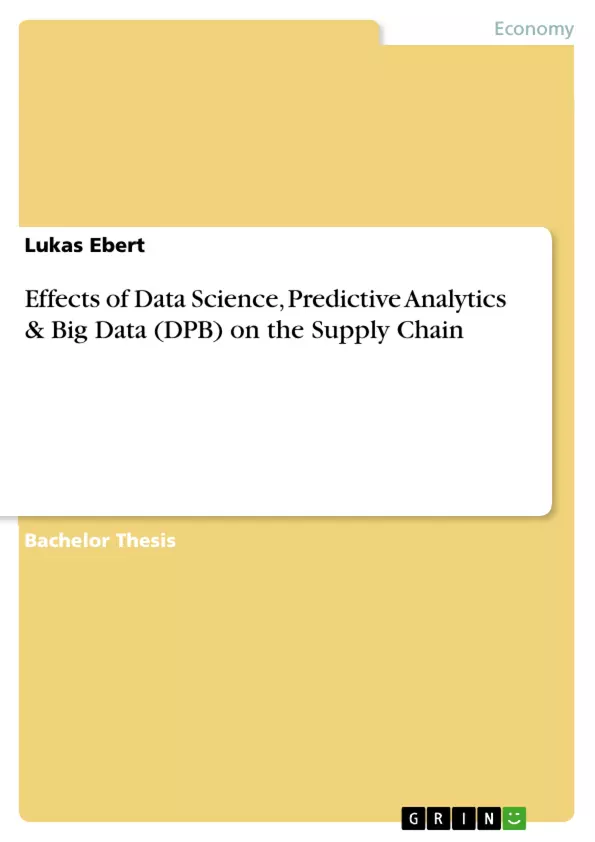A Study on the Opportunities and Threats of Data Science, Predictive Analytics & Big Data (DPB) on the Services Supply Chain on the example of a key player in the german leasing/financial services market.
Working for a financial service provider raises the awareness for certain issues within this sector and how those could be solved by means of new trends such as big data.
This undergraduate thesis presents an exploration of the effects of big data on the supply chain and on decision making. A topic of significant relevance, especially since the literature review discovered that there had been insufficient research conducted on the supply chains of service providers. Furthermore, this investigation of existing literature created a frame for the content of the dissertation by displaying the roots and development of big data and its farreaching impact in and beyond the business context.
The research method that was used for this dissertation consists of qualitative data collection by interviewing employees of a key player in the German leasing and asset finance market, providing insight to the business from the industry leaders viewpoint.
After conducting and analysing the input, the key findings on one hand corresponded with parts of the reviewed literature in terms of the application of big data and on the other hand filled the identified gap regarding services supply chains. More specifically, as a tangible outcome an exemplary supply chain framework was created, based on the identified opportunities and threats regarding an implementation of big data as well as their critical evaluation.
The results ranged from chances for increased efficiency of background processes and improved effectivity of sales processes, leading to a greater profitability on one side, to being confronted with issues of privacy, economic viability and the adaptions caused by the better decision making stemming from enhanced insights through data science, predictive analytics and big data, on the other side.
In order to fully exploit these identified opportunities, further research within this field is recommenced, especially in regard to the increasing relevance of the sector and the megatrend itself as well as the actual technical implementation.
Inhaltsverzeichnis (Table of Contents)
- Abstract
- Acknowledgements
- 1. Introduction
- 1.1. Background of the Research
- 1.2. Research Question
- 1.3. Research Objective
- 1.4. Structure of the Dissertation
- 2. Literature Review
- 2.1. Development of Big Data
- 2.2. Impact of Big Data on Supply Chain
- 2.3. Application of Big Data in Supply Chain
- 3. Research Methodology
- 3.1. Qualitative Data Collection
- 3.2. Interviewing Techniques
- 3.3. Data Analysis
- 4. Analysis and Results
- 4.1. Interview Findings
- 4.2. Interpretation of Findings
- 4.3. Supply Chain Framework
- 5. Discussion
- 5.1. Opportunities and Threats
- 5.2. Critical Evaluation
- 6. Conclusion
- 6.1. Summary of Findings
- 6.2. Recommendations for Future Research
- References
- Appendix
Zielsetzung und Themenschwerpunkte (Objectives and Key Themes)
This dissertation investigates the effects of big data on the supply chain and decision-making within the financial services sector. It addresses the lack of research on the application of big data in service provider supply chains.
- The impact of big data on supply chain processes
- Decision-making processes in the context of big data
- Opportunities and challenges of implementing big data in service provider supply chains
- A proposed supply chain framework leveraging big data opportunities
- The role of data privacy and economic viability in the implementation of big data solutions
Zusammenfassung der Kapitel (Chapter Summaries)
- Chapter 1: Introduction
- Chapter 2: Literature Review
- Chapter 3: Research Methodology
- Chapter 4: Analysis and Results
- Chapter 5: Discussion
This chapter introduces the research topic, its significance, and outlines the research question and objectives. It also provides a structure for the dissertation.
This chapter explores the development of big data, its impact on supply chains, and its various applications within the context of supply chain management. The chapter analyzes existing literature to establish a framework for understanding big data's implications in the service sector, particularly in the supply chain.
This chapter outlines the research methodology employed in the dissertation, focusing on qualitative data collection through interviews with employees of a leading German leasing and asset finance company. The chapter describes the interview techniques and data analysis methods used to gain insights into the company's operations and challenges related to big data implementation.
This chapter presents the findings of the interviews, analyzing the data to identify opportunities and threats related to big data in supply chain management. It explores the impact of big data on various aspects of the company's operations, including background processes, sales efficiency, and decision-making. The chapter also introduces a proposed supply chain framework based on the collected data and analysis.
This chapter delves into a discussion of the opportunities and threats identified through the research, providing a critical evaluation of the potential benefits and drawbacks of big data implementation in the service sector. The chapter examines the implications of data privacy, economic viability, and adaptability within the context of big data.
Schlüsselwörter (Keywords)
The main focus of this dissertation lies on the application of big data in supply chain management and its impact on decision-making within the financial services sector. Key themes include: big data, supply chain management, business intelligence, data analytics, service provider supply chains, opportunities and threats, data privacy, economic viability, and decision making.
- Quote paper
- Lukas Ebert (Author), 2017, Effects of Data Science, Predictive Analytics & Big Data (DPB) on the Supply Chain, Munich, GRIN Verlag, https://www.grin.com/document/998029



